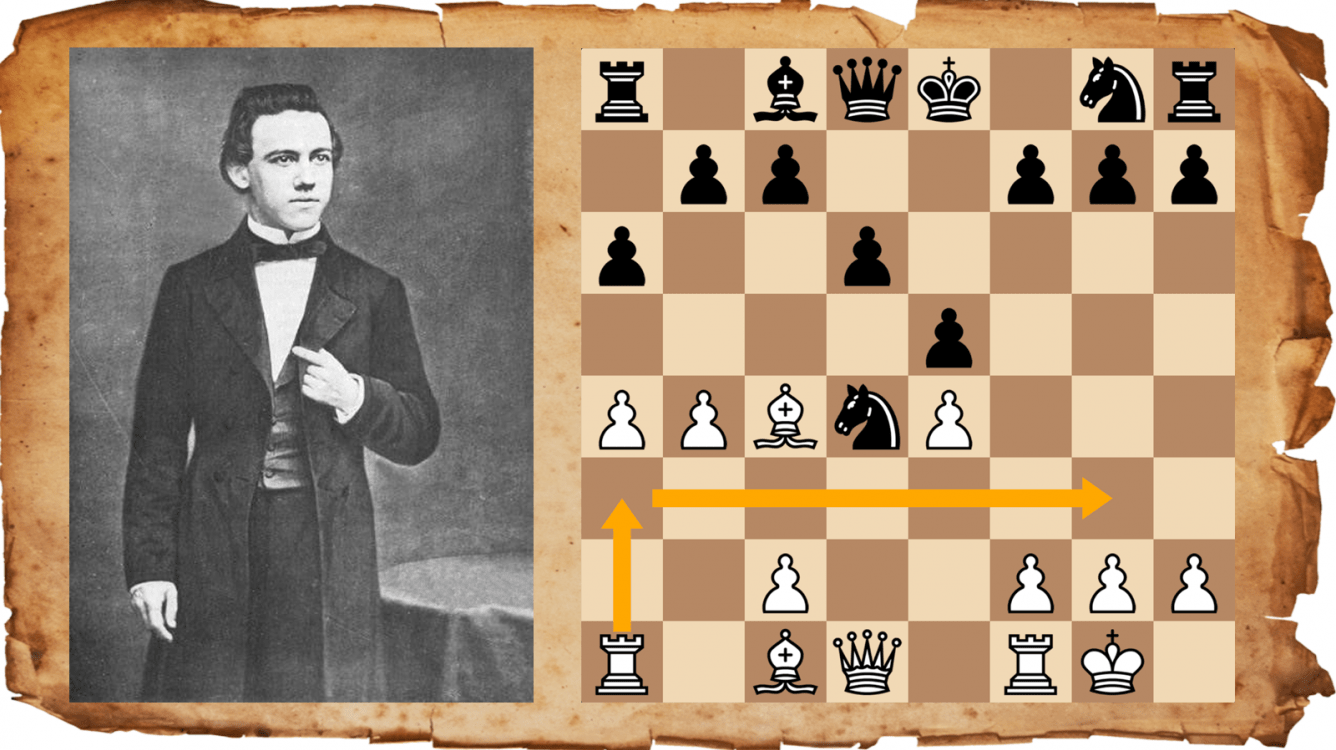
The Rook Lift: Paul Morphy's Last Gift To Chess
In the late 1860s, the legendary Paul Morphy had almost entirely retired from chess. He was not the same young genius that he once was. But he still managed to introduce an important opening idea which hadn't been seen in chess before.
After the American Civil War, which seemed to have traumatized him in several ways, Morphy tried to start a career as an attorney with very limited success. In 1867, he was in Paris during the International Chess Congres (Kolisch won, ahead of Winawer and Steinitz), but he never once visited the tournament. When he returned to New Orleans in 1869, he played what appears to have been his last recorded chess games against his closest friend, Charles Maurian (1838-1912).
The games mostly have significance as curiosities. Morphy generally didn't play well, and Maurian was simply too weak for his level. Moreover, the games were played "at odds." Morphy started with a knight down. The match didn't go particularly well for Morphy either. Biographer David Lawson, author of "Paul Morphy, The Pride and Sorrow of Chess" (2010), writes that:
after the conclusion of the Fourth Series in December 1869, Morphy told Maurian that he was now too strong to receive odds of Knight and that hereafter he would allow him the odds of Pawn and two moves only.
However, in one of these games Morphy did do something creative and quite unusual:
The concept of a "rook lift," transferring the rook to the center or the other flank, was not a common theme in the 19th century. In fact, it was brand new. Early rook moves were rare in general in this period, and they usually only happened out of necessity, such as when the rook was attacked and was forced to move from its original square. The idea of lifting your rook in order to swing it to the other side of the board had lasting consequences for certain openings.
 |
Can you play like Paul Morphy? Try our Play Like Paul Morphy course featuring five of Morphy's best games! |
Play Now! |
Let's have a look at some pioneers of the rook lift. For some spicy originality, you could always count on Henry Bird (1829-1908), the English chess master who gave his name not only to the sharp 1.f4 but also to a line in the Ruy Lopez starting with 1.e4 e5 2.Nf3 Nc6 3.Bb5 Nd4 (a move still sometimes played at the grandmaster level).

Here's a game of his in that opening:
A wonderful application of the same idea!
We'll return to this maneuver soon, but we should note that this was a rare bird (pardon the pun) in those days, and it wasn't until the 1930s that another brilliant and creative player, Paul Keres, rediscovered the rook lift (perhaps without knowing of the previous examples) and applied it in a practical game:
Of course, even before this game, early rook moves did occur occasionally and not only with attacking intentions. In the following little-known example, future World Champion Alexander Alekhine applies it strictly for defensive purposes:
There are more variations where Ra1-a2 (or Ra7-a8 for Black) is a useful defensive mechanism, for instance in the French Winawer. Once White goes Qd1-g4, it's often important to defend the pawn on c2. Alternatively, in the Semi-Slav Defence with an early ...a6 (called the Chebanenko Variation) when White attacks b7 by means of Qd1-b3, Black replies with a cool and collected rook move to a7.
But let's get back to Henry Bird's game. The idea of playing a7-a5 and Ra8-a6 has actually become a key idea in the Budapest Gambit, and without it, this opening would probably not be as popular as it is at the club level. However, even super-grandmasters can play very entertaining games with it. Here's just one fun example by the great Shakhriyar Mamedyarov:
Even more adventurous is a line against the Sicilian, advocated by Simon Williams in one of his Chess.com lectures. This one hasn't been tried out a lot in practice yet, but it's definitely worth a look.

These are all cases where the queen's rook swings to the other side, but this last example, where white plays an early h2-h4, is a good reminder that sometimes, such a rook lift is possible from the other side.
One of the most common openings in which such a maneuver occurs is the French Defence. Here's the oldest game I could find demonstrating the archetypical idea:
And here's Mikhail Tal, the 8th world champion, showing another version of the same concept:
Such rook lifts don't only happen in the French. In the early 80s, GM Jonathan Speelman introduced an interesting new idea in the Keres Attack of the Sicilian:
There are other rook lifts in the Sicilian as well, such as when Black plays (after ...a6 and ...b5) the moves Ra8-a7-d7, defending the vulnerable Black center against early attacks from White. This is an especially important idea in the Polugayevsky Variation where it is an absolutely essential resource for Black to survive many critical positions.
Speelman has more experience with "rank roaming rooks," as John Watson calls the phenomenon in his book Secrets of Modern Chess Strategy (1998). He quotes the following game:
Watson notes:
It is quite odd to bring a rook to the third rank before any of the minor pieces are developed!
In fact, Watson is one of the few authors who discuss the motif in a thematic way, remarking that:
Modern chess players are more apt to embark upon rook adventures than their predecessors, although this still doesn't constitute a major part of the game.
Regarding Speelman's direct inspiration for his idea in the Sicilian, it's just possible that during the game, or during the preparation for it, Speelman actually remembered another curious game he himself had played years before. There, he adopted the king's rook maneuver from the Black side, in a position rather similar to the French setups we've looked at:
Such rook lifts on the kingside for Black are much rarer. Sometimes, the maneuver is used to develop the rook, when casting is simply not possible or desirable. The following is a cool example, if only because of the player of the black pieces, Magnus Carlsen, was still only 14 years of age. White is now a well-known Norwegian chess journalist.

Later in his career, Carlsen played his fair share of rook lifts. I especially like this one from last year's Sinquefield Cup. Although strictly speaking it occurred in the endgame, it's worth showing the game in full because of all the wonderful rook moves!
That was one of the highlights of last year. It reminded me of another game I had once seen in which the white rook from a1 also made an unlikely journey to the h-file. In fact, it's even more amazing than Carlsen's. This one actually does feature a "true" rook lift in the opening, in a variation of the Nimzo-Indian where such maneuvers are indeed rather common.
The player responsible for its execution? Alexey Shirov. One of the most entertaining chess players of the last few decades!
We've seen examples of rook lifts by many great players from the past and present; the maneuver can be employed both for defensive and aggressive purposes. This is really just a very small selection of what's possible in terms of rook lifts. I encourage you to find more cases yourself! Just remember that it all started with a casual knight odds game between two old friends. We could call rook lifts "Morphy's last gift to chess."

